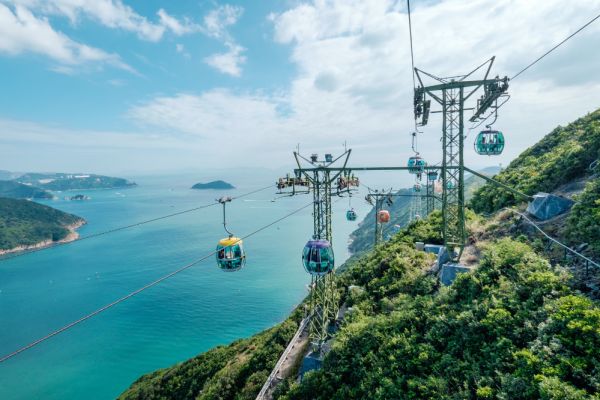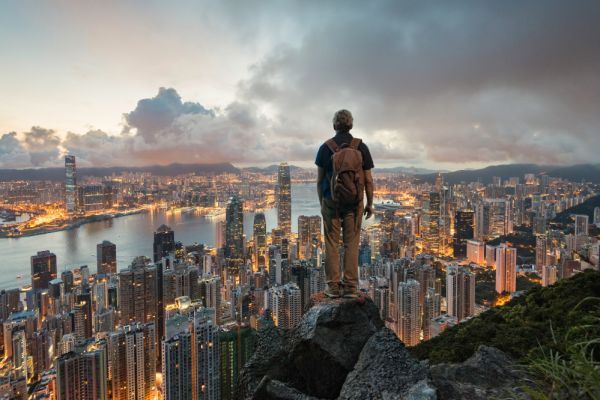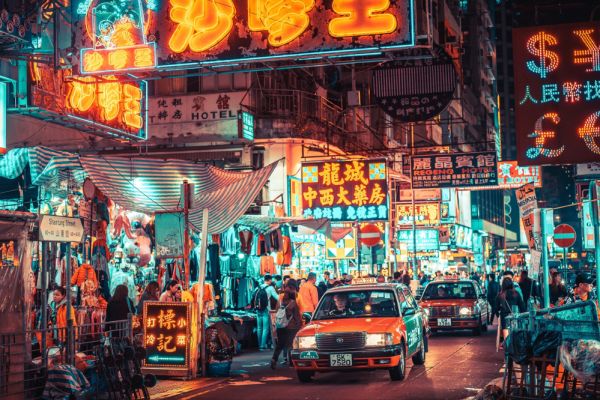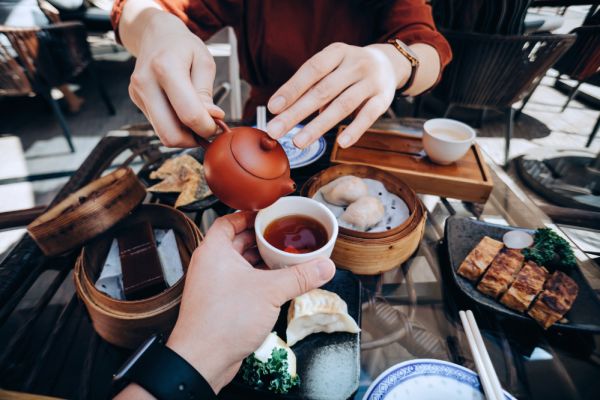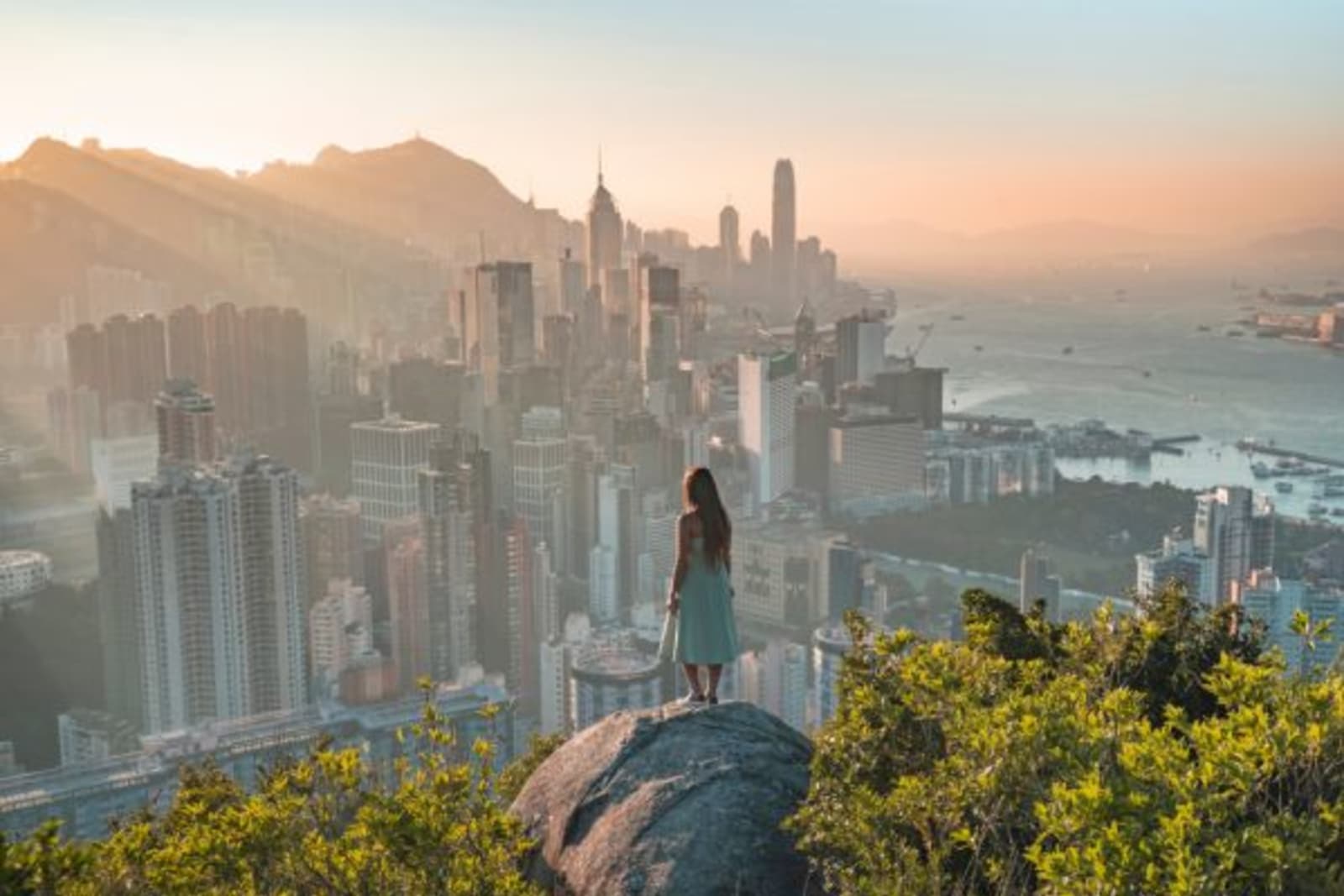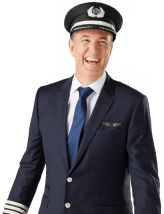Hong KongTravel Guide
Kowloon for old-meets-new, street markets and heritage hotels; Hong Kong Island for dazzling skyscrapers and Victoria Peak; Lantau Island for Hong Kong Disneyland, beaches and the Big Buddha… There are so many wonderful experiences to be had in Hong Kong. Are you a foodie? (You’re in the right town.) Culture buff? Mad for markets? Love a nature hike or just want to meander at leisure? With a little planning, you can really make the most of your time in Hong Kong.We’ve collected the very best travel tips from our travel experts and you’ll be able to read them here, in our Hong Kong travel guide. Check out our experts’ suggestions for things to do, the best time to travel (don’t forget that brolly!), where to stay in Hong Kong, getting around and more. We even have a guide to Hong Kong Airport for a smooth arrival and departure.
Explore Hong Kong
Where to stay in Hong Kong?
There are three major locations you have to choose from when you’re planning where to stay in Hong Kong. These are Hong Kong Island, Kowloon Peninsula and the New Territories (including several outlying islands as well as Hong Kong’s largest island, Lantau). Each has its own pros and cons, so it just depends what you’re looking for. If you want to remain in the heart of the action, the neighbourhoods in the north of Hong Kong Island or on Kowloon Peninsula are your best bet, with the other islands offering an entirely different, and less frenetic, Hong Kong experience.
This area is the business and entertainment hub of Hong Kong. Central puts you in close proximity to the Peak and the Peak Tram, but it can also be one of the more pricier districts of Hong Kong. There are lots of hotels in this area and also plenty of nightlife. You're close to the Star Ferry departure point and the Hong Kong Observation Wheel. In short, you're in the centre of it all.
Wan Chai and northeast Hong Kong Island will put you in close proximity to Hong Kong Park, Happy Valley Racecourse and shopping; plenty of eating and drinking options; as well as great transport links. Wan Chai was one of the first districts to be inhabited by the British, and is dotted with history and culture despite its slightly gritty appeal. Nearby is Causeway Bay, known as one of the greatest shopping destinations in the world.
Tsim Sha Tsui is one of the busiest districts in Kowloon, on the mainland. This area on the tip of Hong Kong peninsula is popular for one main reason: its close proximity to Victoria Harbour and the iconic Hong Kong skyline. Home to fascinating museums, intimate communities, and plenty of old-worldly heritage, Tsim Sha Tsui houses many top restaurants and world-class attractions. There's also the lush Kowloon Park just five minutes away, if you're in need of some green space.
If you are looking for pristine beaches, beautiful landscapes and less hustle and bustle, Lantau Island is a wonderful place to stay. It's also the location of Hong Kong Disneyland Resort, the Tian Tan Buddha Statue (known as the Big Buddha) and Po Lin Monastery, so does draw quite a crowd to these specific attractions. Hong Kong Disneyland Resort has three different hotels on site, so you could very easily spend your entire holiday there and never run out of things to do.
Believe us when we say, this is just the start. Book your Hong Kong accommodation today!
Things to do in Hong Kong
There’s always something happening in this buzzing world city, and if you’re wondering what to do in Hong Kong, start at the top. Victoria Peak offers spectacular views of the harbour and city, and will give you a glimpse of just how much you need to cram into your itinerary while you’re in town! Explore our guide to some of the best Hong Kong attractions, below, and have fun discovering this truly East-meets-West destination.
There's no arguing that Victoria Peak, the highest point on Hong Kong Island, is like a magnet for tourists. Yet what's just as memorable as those sweeping views is the thrilling ride up to the top and down again. Travelling in Hong Kong's 130-year-old Peak Tram is one of the city's most unique experiences. Over the years, the Peak Tram has been carefully maintained, however the Peak Tram Upgrade Project from 2018-2021 will enable more passengers to enjoy this very special journey. If you're riding Hong Kong's Peak Tram, look out for the Peak Tram illusion. This is a phenomenon whereby passengers experience a visual illusion going uphill: if you're sitting on the right side of the tram, the skyscrapers will appear to lean into the hill. If you're a movie buff, look out for the 1955 film Soldier of Fortune, which was filmed when Hong Kong's Peak Tram carriages were painted green.
At 34m high, this ‘Big Buddha' as it is colloquially known, is the world's largest seated outdoor bronze and gold Buddha statue. Tian Tan Buddha sits tranquilly on top of a lotus throne, opposite the Po Lin Monastery and gazes north toward mainland China, offering its blessing. It is one of the most beautiful places in Hong Kong to visit, surrounded by the lush mountainous landscape of Lantau Island. The Big Buddha was completed in 1993 and if you want to get a close-up look at the 202-tonne statue, you can climb the 268 steps and be rewarded with some pretty impressive views when you get to the top. If all that walking gives you an appetite, you're in luck. The operational Po Lin Monastery is not only one of the most important Buddhist sanctums, its popular vegetarian restaurant offers some super-tasty sustenance. The monastery gardens are also lovely to wander around, abundant in flowers and birdlife, while the beautiful Lantau Tea Garden – the only tea garden in Hong Kong – is a short 10-minute walk away.
One of the most quintessential Hong Kong experiences is a day at the races. Happy Valley Racecourse staged its first race back in 1846 and the Hong Kong Jockey Club is one of the city's oldest and most powerful entertainment institutions. Redeveloped into an international calibre racing facility in 1995, the curved façade of Happy Valley's grandstand dominates the main straight of one of horse racing's most iconic venues, which is surrounded on all sides by the city's dazzling skyscrapers. This seven-storey grandstand accommodates more than 55,000 spectators, and watching your horse hit the lead in the home stretch is an exhilarating experience. While it might not be easy to line your holiday up with the Hong Kong Derby or Champion's Day, Happy Valley's traditional Wednesday night races are one of the must-do experiences in Hong Kong, raking in millions of dollars and raising the buzz around the track to fever pitch. Hong Kong's only other track is at Sha Tin Racecourse in the New Territories, and is also a fun day out.
A popular Hong Kong tourist attraction as well as a firm favourite with locals, Victoria Park is the largest area of green space on Hong Kong island and an oasis of serenity in this bustling city. If you visit the park early on a weekday, you'll be treated to the mesmerising spectacle of people practising the flowing movements of Tai Chi. Victoria Park offers visitors large swathes of green grass as well as a bowling green, football fields, basketball courts, tennis courts, an outdoor swimming pool and several jogging tracks. There are quite a few things you can't do in the park, such as play music or fly a kite, so make sure you note the regulations beforehand. The park comes alive even more than usual during the Mid-Autumn Festival, when it's transformed by glowing lanterns, and just before the Lunar New Year, when a large flower market is held here. The best way to get to the park is to take the MTR (Mass Transit Railway) and hop off at Causeway Bay Station.
It's a must-do in Hong Kong – getting out on that world famous harbour in one of the humble Star Ferries. These boats have been taking passengers from Hong Kong Island to Kowloon and back since 1888. Today their popularity shows no sign of abating: visitors enjoy the iconic Hong Kong experience and the chance to take some pics of this photogenic harbour, while locals jump on a ferry to avoid the peak hour traffic jams and commuter crowds. The names of the original four vessels were Morning Star, Evening Star, Rising Star and Guiding Star, although now you might be lucky enough to jump on a Celestial Star or a Twinkling Star, among others. It's only a 10-minute journey across the harbour, and the most dramatic route is from Kowloon to Central, especially on a cloudless evening. Ferries depart every 10 to 12 minutes, and travel two routes, from Tsim Sha Tsui in Kowloon to either Central or Wanchai, both on Hong Kong Island. Tickets are slightly more expensive for the top deck, but you'll have a much better view.
Clinging to a cliff face which offers sweeping views of the South China Sea and parted in the middle by an iconic mountain range, this sprawling aquatic-themed amusement park is one of Hong Kong's oldest and best-loved tourist attractions. Ocean Park Hong Kong can be divided into two distinct areas: the Waterfront and Summit, which are connected by cable car and Ocean Express funicular train. Before we even get to the attractions, it's worth noting that these two modes of transport are amazing things to do in their own right, with sweeping ocean views available from the cable car ride and the sensation of travelling underwater recreated by the funicular railway. So then, what are the best attractions at Ocean Park Hong Kong? There's Shark Mystique, which takes you on a journey deep underwater to meet over 100 sharks; Polar Adventure, which takes you on a bobsled ride and gives you a chance to explore both North and South poles; Aqua City, featuring the world's first 360-degree water screen, and so much more.
All those images of Hong Kong's incredible skyline are captured here. Victoria Peak has attracted people to its summit since colonial times, and remains one of the most important Hong Kong landmarks. From the top, you can gaze out over the sparkling skyscrapers, the expanse of Victoria Harbour and, on a clear day, you can see as far as the New Territories. The historical Peak Tram funicular railway is one of the oldest and steepest funicular railways in the world and an experience in itself (see above). For the best views from Victoria Peak, head to Peak Tower and travel up to level 5. Here you'll arrive at Sky Terrace 428 which is – you guessed it – 428m above sea level and offers those breathtaking 360-degree views.
If you're yearning for that ‘sprinkle of pixie dust' feeling while on your Hong Kong getaway, Hong Kong Disneyland is ready and waiting for you. Packed with all the Disney fun you would expect, Hong Kong Disneyland brings a little flavour of Hong Kong to the experience too. You may not even notice, but the design incorporates Feng Shui and traditional Chinese elements such as the colour red, lots of water features and a north-south orientation of the theme park to encourage good fortune. The different ‘lands' that you can visit within Hong Kong Disneyland include Adventureland, Fantasyland, Grizzly Gulch, Main Street U.S.A, Mystic Point, Toy Story Land and Tomorrowland, with this final land incorporating the Iron Man Tech Showcase and Star Wars Command Post. Even though there are a dizzying array of restaurants and food outlets, if you want a fun and delicious treat unique to Hong Kong Disneyland, stop into the Crystal Lotus restaurant inside the Hong Kong Disneyland Hotel. Here you can take your pick from the special dim sum menu filled with all your favourite Disney and Pixar characters… too cute to eat?
The largest outlying island in Hong Kong offers a wonderful mix of experiences, from the universal fun of Hong Kong Disneyland to the tranquil walking paths and fishing villages dotted around the coast. Lantau Island is also where you'll find the Big Buddha and Po Lin Monastery. If a spiritual theme is what you're after, seek out the Wisdom Path, set in the hills of Ngong Ping just a short walk from the Big Buddha. Wisdom Path is marked by a series of 38 wooden upright monuments containing verses from the centuries-old Heart Sutra, one of the world's best-known prayers. Other highlights of Lantau Island are the themed village of Ngong Ping 360; the stilt houses of the Tanka boat people in the historical fishing village of Tai O; the beautiful Cheung Sha Beach and Pui O Beach; and the endangered ‘pink' dolphins which frolic in the waters to the east of Lantau Island. You may be lucky enough to glimpse on one of the dolphin-watching tours organised by Hong Kong Dolphinwatch (departing from outside the Kowloon Hotel, on the mainland).
Set atop a hill on Lantau Island, Ngong Ping 360 is culturally-themed village offering visitors a panoramic view of Lantau and plenty of activities. Getting there is one of the biggest drawcards, with a world-renowned cable car experience taking you from Tung Chung to Ngong Ping. Options include a private cable car cabin and the Crystal Cabin, which has a glass bottom for greater views. You can use Ngong Ping village as a starting point for a day trip that could include the Big Buddha, Tai O fishing village, Po Lin Monastery, the Wisdom Path, Lion Hill, Tiger Hill and more. Set on a scenic 1.5 hectares, Ngong Ping Village has plenty of cafes and eateries, shops, and entertainment such as VR 360 and Motion 360.
Symbolic of days gone by, the traditional junk boat with its red sails presents a striking image as it cuts its way across Victoria Harbour. The original junk boat, or sampan, is Duk Ling. This flat-bottomed Chinese wooden boat is an authentic fisherman's boat which underwent a full restoration in the 1980s, sank during a typhoon in 2014, and has now been retrieved and painstakingly restored. It is joined by more modern vessels (built to resemble the traditional boats) such as the Aqua Luna and the Aqua Luna II. Plan ahead if you wish to experience this popular Hong Kong attraction, because spaces are limited with Duk Ling only taking 36 passengers, for example. Junk sailings around the harbour will take around 45 minutes and if you want the deluxe option, Duk Ling is even available for charter.
Looking for an immersive experience? Then a Hong Kong tour is the way to go.
Hong Kong travel tips
Hong Kong has Chinese roots, colonial heritage and a 21st century outlook, which makes it a fascinating place to visit. With so many different influences, a few Hong Kong travel tips will certainly come in handy.Hong Kong is officially regarded as a Special Administrative Region of the People’s Republic of China. The area was a British Colony for over 100 years, and handed back to China in 1997. This British legacy has created a destination that it is truly unique, and in every neighbourhood you’ll discover the fascinating stories of Hong Kong’s past and present.
If you're visiting Hong Kong for tourism for less than 90 days, you generally won't need to organise a visa in advance. Note that if you plan to travel between Hong Kong and mainland China, you'll need a visa. Also be aware that these arrangements can change with short notice, so we recommend you refer to the Australian Government's Smartraveller website to get the latest information on what you need to know about travel to Hong Kong.
Food in Hong Kong is one of the city's highlights, and there are a few dishes you really shouldn't leave without trying. If one food symbolises Hong Kong, it is surely the dim sum – bite-sized steamed dumplings and rice noodle rolls are a core component of traditional Cantonese cuisine and as such, heading out to “drink tea” – or yum cha – is one of the most authentic Hong Kong dining experiences around. Stir-fried crab, barbecued pork and congee are some of the other culinary favourites.
Hold on to your UK adaptors! In most cases, electrical outlets in Hong Kong take a three-pronged UK-style plug, which makes things easy. The standard electrical voltage in Hong Kong is 220 volts AC, 50Hz. Most hotel bathrooms also have outlets for 100 volts, but if not, you will need a transformer for any appliance or electrical equipment.
Hong Kong International Airport is located on the island of Chek Lap Kok and is one of the world's top ten busiest airports. There are two terminals, and the airport is known for its state-of-the-art facilities and fantastic service. It is often referred to as Chek Lap Kok Airport and you certainly won't be bored if you're spending a few hours there – over 320 shops and 100 restaurants.
The currency in Hong Kong is the Hong Kong dollar (HKD), which is pegged to the US dollar and therefore pretty stable. The value obviously fluctuates but one Australian dollar is worth around 5HKD. Credit cards are widely accepted and Hong Kong is also well equipped with ATMs, allowing you fast access to funds without the risk of carrying cash.
There are a few customary practises for tipping in Hong Kong. In most restaurants, it's not expected because many establishments add a 10% service charge to the bill. Check the bill to find out. In fancier restaurants, tipping is not expected but many customers do tip in the top restaurants. Tipping is usually expected for hair salons and beauty treatments, but not so much in cafes. Tip in hotels if you have bellhops, room service, a valet and concierge looking after you.
Thanks to its history, Hong Kong has two official languages: Chinese and English. Cantonese is spoken by the majority of the population, but Mandarin (the official dialect of China) has become more widely spoken since the reunification of 1997. The preferred language of the Government and business is English, and all signage is bilingual.
Flights to Hong Kong
Hong Kong food and drink
When it comes to eating out and eating well, Hong Kong is a veritable smorgasbord of sublime tastes and tastebud-tantalising styles. From its Chinese-influenced dim sum scene to fresh-off-the-boat seafood and some of Asia’s finest fusion dining, there’s no shortage of impressive places to eat in Hong Kong.Hong Kong dining runs the gamut from streetside hawker fare to upscale Michelin-starred restaurants and includes everything in between. Some Hong Kong residents eat out every night of the week, so enjoying a sumptuous meal is often as simple as stepping outside and taking a seat at the nearest eatery.
Foodie neighbourhoods are gloriously abundant in Hong Kong, and there are over 14,000 restaurants in the city. The Starstreet precinct on Hong Kong Island is a fashionable (and vast) dining neighbourhood, the gourmet hub of Kowloon City offers up a host of Asian specialties, and the range of delicacies to be found on Hau Fook Street make it one of Kowloon's best-kept secrets.
From Olympia Graeco Egyptian Coffee (Hong Kong's oldest coffee shop, founded in 1927) to modern specialty coffee stores like Elephant Grounds, Cafe Corridor and 18 Grams, Hong Kong knows its coffee and there are dozens of incredible coffee shops across the city. If you fancy popping in to an Australian-style coffee shop, check out Barista Jam in Sheung Wan.
Hong Kong turns on the style when the sun dips below the skyscrapers looming over Victoria Harbour, with this cosmopolitan city home to some of Asia's hottest nightclubs and most vibrant bars. From casual drinks to full-blown nights on the town, Hong Kong's nightclub and bar scene provides yet another compelling reason to visit a destination which proudly proclaims itself to be Asia's world city.
Hong Kong food markets are also known as ‘wet markets', because all that fresh seafood is set on ice and… you get the idea. The ‘cooked food markets' within the wet markets are where you'll find plenty of hidden culinary gems. Try Tai Po Hui Market and Cooked Food Centre, although there are 64 wet markets that have cooked food stalls in Hong Kong, so you can eat your heart out!
Get a real taste for the local cuisine by booking a Hong Kong tour.
Hong Kong through your eyes
Where to shop in Hong Kong?
Shopping in Hong Kong is a popular pastime for both locals and visitors alike, with retail outlets all over the city. Products range from simple Chinese teas to top-of-the-line brand-name watches, and given that Hong Kong is home to some of Asia’s wealthiest residents, it’s no surprise that luxury items abound in this glittering modern metropolis. From Central to Causeway Bay, Mong Kok to Tsim Sha Tsui and countless locations in between, Hong Kong is home to some of the best shopping in Asia. Harvey Nichols is here, as is luxury mall Landmark, while the presence of dozens more shopping centres and boutique outlets ensures you’ll never leave empty-handed from a holiday in Hong Kong.
What this bustling metropolis arguably does best is high-end shopping centres. There are plenty of them dotted around Hong Kong Island, Kowloon and even Lantau, making shopping under one roof a breeze in this dedicated retail hotspot. Our tips include Landmark (for upscale window shopping, if nothing else), Harvey Nichols, Harbour City and Langham Place.
Markets are abundant in Hong Kong, where the South China practise of grouping like items in one street means that you can check out shoe markets, electronics markets, antique markets, toy markets and more. For something different, don't miss the Goldfish Market in Mong Kok, the Jade Market in Yau Ma Tei, Kowloon, and the famous Temple Street Night Market.
The main Hong Kong shopping precincts are in Kowloon and Hong Kong Island. In Kowloon, check out Tsim Sha Tsui for clothing, jewellery and fashion accessories, and West Kowloon Cultural District for luxury brands and electronics. On Hong Kong Island, Central is all your luxe brands, Causeway Bay is a shopping must-do, Hollywood Road and Cat Street Bazaar sell antiques, jade, wooden handicrafts, and Stanley is where you'll find Chinese arts and crafts, toys and souvenirs.
Looking for a safe and simple way to bring your money when you travel? Our Travel Money Card has you covered!
When is the best time to travel to Hong Kong?
There’s really no wrong time to visit Hong Kong. Summers can be extremely hot and humid (nothing new for Australians) and even though winters can be chilly, you won’t find a giant snow drift stopping you from getting out and about. The weather is clearly a factor in deciding on the best time to travel to Hong Kong but don’t forget that this city has an incredible calendar of events. Hong Kong loves a festival, so check out what’s on as you’re working your way through which season might be the best time to travel.
Summer in Hong Kong can be hot and sticky. On the plus side, many of the residents tend to leave the city between June and August, so you can expect it to be a little less crowded. This is also typhoon season, so afternoon thunderstorms are common. Appropriate clothing: Summer clothes and possibly long sleeves in a light fabric if you want better sun protection Don't forget: An umbrella or raincoat, and a hat.
Winters in Hong Kong will give you average temperatures of between 14 and 19 degrees celsius, so not arctic but certainly chilly enough to warrant chestnut-roasting street stalls and mulled wine. There's that English legacy. Winter is a wonderful time to visit Hong Kong, as the city is lit up for Christmas and puts on one epic New Year's Eve fireworks show. Appropriate clothing: Long trousers, warm shirts, and jackets Don't forget: A scarf if you're going out on the water… brrr!
From September to November is when Hong Kong experiences Autumn weather, when the humidity drops along with the temperature – but not by too much. Average highs in September are around 30 degrees celsius, dropping to average highs of 24 degrees in November. This is one of the best times to visit Hong Kong, when it has the Mid-Autumn Festival and the mesmerising lantern carnivals that go along with it. Appropriate clothing: Summery clothes. Don't forget: A light jacket or wrap for evenings.
Springtime is beautiful in Hong Kong and although it doesn't have the cherry blossoms of Japan, Hong Kong's official floral emblem, the Bauhinia (commonly known as Hong Kong's orchid tree) is in bloom with its cheery magenta flowers. Temperatures are starting to rise after winter, reaching average maximums of between 21 and 28 degrees celsius. Appropriate clothing: Layers, including a warm jacket Don't forget: the sunscreen.
Don't miss out. Book your Hong Kong flight today!
How to get around Hong Kong
Getting around Hong Kong is a breeze, with one of the world’s fastest, safest and easiest public transport systems, abundant and cheap taxis, as well as ferries that offer incredible views as they take you from A to B. The Mass Transit Railway (MTR) is Hong Kong’s rail network, comprising overland, underground and light rail. Trams also run throughout the city, as do mini buses, night buses and several rideshare services. Hong Kong is also a great city in which to do some walking, with scenic strolls and invigorating climbs – take your pick.
It's not difficult to find a taxi in Hong Kong, with more than 18,000 cruising the streets of the territory. Red taxis service Kowloon and Hong Kong Island, green-with-white-top taxis service the New Territories and blue taxis service Lantau Island. They're easy to flag down, are metered and cheap. Several rideshare services also operate throughout Hong Kong, such as Uber, Fly Taxi, eTaxi and SuperCab.
Keen to rent a bike and take to Hong Kong on wheels? Hong Kong has some incredible cycling routes. One of the most scenic would have to be from Tai Po to Tai Wai/Sha Tin. Bikes can be rented in the park at Tai Po, and from here you'll travel along the Tai Po waterfront, pass numerous cafes (or not pass, if you fancy stopping for a refreshment) and travel along the Tolo cycling track, the Pak Shek Kok Promenade and through the Hong Kong Science Park.
Get yourself an Octopus card and you'll find Hong Kong transport ridiculously easy to manage. This is a contactless smart card, and for tourists there is a thing called an ‘On-Loan' Octopus card which comes with a refundable deposit of HK$50. The Octopus card enables you to ride the MTR, buses, minibuses, ferries, trams and yes – even a few taxis equipped with card readers.
There are riches to discover if you want to explore Hong Kong on foot. Lugard Road is a pathway which circles the Peak and at more than 400m above sea level, offers incredible views on a clear day. (Even on a cloudy grey day, it's a moody and unforgettable experience.) There are plenty of walkable neighbourhoods in Hong Kong and if you plan to explore markets, this is the way to go. Don't miss the walk along the Tsim Sha Tsui Promenade for that iconic Hong Kong view.
Let us help you organise your own wheels for exploring. Hire a car in Hong Kong today!
Subscribe to go in the draw to win 1 of 5 $1000* gift cards
PLUS receive a $50* welcome voucher, birthday surprises, exclusive deals, early sale access & MORE!
What are the best parks in Hong Kong?
Hong Kong has many beautiful parks and gardens and offers up a variety of green spaces in which visitors and residents alike can relax and take time out from the city. Some of the parks are vast, such as Victoria Park, which was named after Queen Victoria and is the biggest park on Hong Kong Island. Other parks have different reasons for being, such as Kowloon Walled City Park, built on the site of the once-lawless Kowloon Walled City, which surprises visitors with eight floral walks named for the plants and flowers that grace the paths. Read up on just some of the parks in Hong Kong, below.
This small, beautiful park holds a very important relic and is well worth a visit for its historical significance. The boulder in the park has an inscription which dates from around 1279, and is believed to commemorate the last two boy emperors of the Southern Song Dynasty, Zhao Shi and Zhao Bing.
As the largest park on Hong Kong Island, it's not surprising that Victoria Park is the home of several major festivals in the Hong Kong calendar year, such as the Flower Market before Chinese New Year and various lantern carnivals during the mid-Autumn festival. The park is a sprawling oasis of green, where you can go for a jog, join a game of footy or simply escape from the busy city.
Situated near the Tsuen Wan Ferry Pier, this garden plays off its waterside location and has adopted a quirky nautical theme. It's a great place to take the kids, with the children's cycling area featuring a giant sandcastle-shaped tunnel and lookout tower which overlooks the park. The lush, green space is dotted with flying fish and dolphin sculptures throughout.
Positioned between towering mountains and glittering skyscrapers, Hong Kong Park is a verdant retreat from the urban landscape. Built on the former garrison site of Victoria Barracks in the bustling Central district of the city, this eight-hectare park marries artificial surrounds with green gardens, in fact there is actually a marriage registry within the park should you feel the urge to tie the knot.
Built in the style of the Tang Dynasty, Nan Lian Garden is a tranquil green space set amongst the high-rise apartments of Diamond Hill. Over 3.5 hectares, the meticulously landscaped garden is where you'll find every element precisely where it should be according to ancient rules and methods. Each rock, hill, plant, body of water and timber structure is placed in just the right spot – and the experience is magical.
Getting from park to park is so much better with your own wheels. Hitch your ride now!


